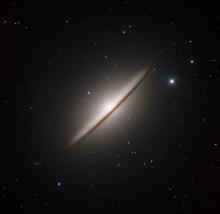Listen to today's episode of StarDate on the web the same day it airs in high-quality streaming audio without any extra ads or announcements. Choose a $8 one-month pass, or listen every day for a year for just $30.
You are here
Brilliant Demise
Most stars die in obscurity. The stars are so far away, and their final acts are so faint, that we never see them. But a year ago today, telescopes saw the death throes of a star that was 12 and a half billion light-years away. The star was ripped apart by a supermassive black hole.
The death was known as a tidal disruption event. Astronomers have seen several of them, but this was by far the most distant. The star was roughly the mass of the Sun. It swung close to a black hole at the heart of a galaxy. The black hole is about five million times the mass of the Sun — about the size of the black hole at the heart of the Milky Way.
The event was named AT2022cmc. It was first seen by an automated telescope that observes the sky at visible wavelengths. It soon was picked up by many more telescopes at many more wavelengths.
As the star approached the black hole, the black hole’s gravity ripped it apart in a blaze of light. About half of the star’s debris was captured by the black hole. It joined a disk of superhot gas around the black hole. The process produced shockwaves that generated X-rays and ultraviolet light.
Some of the material was flung away from the poles of the black hole in high-speed jets of particles and radiation. One of the jets was aimed at Earth, so the star’s death was especially bright — one of the brightest objects astronomers have ever seen.
We’ll talk about another black hole tomorrow.
Script by Damond Benningfield





